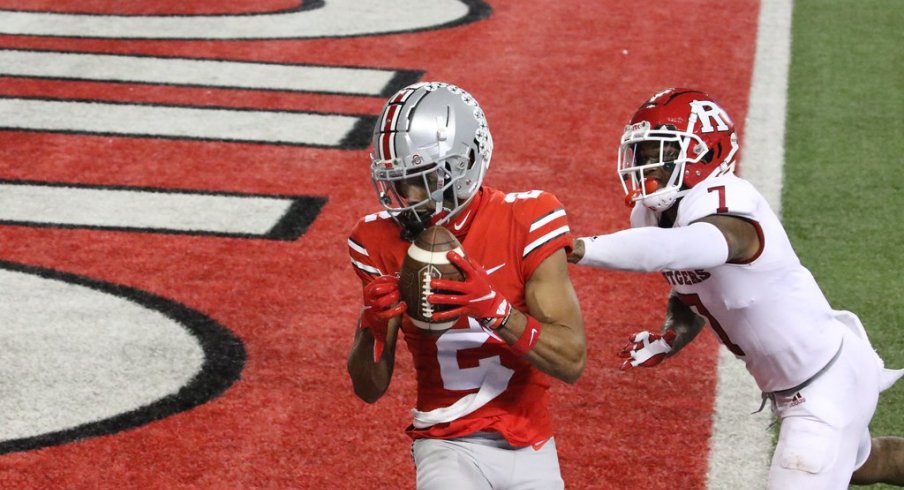Justin Fields, Garrett Wilson, and Chris Olave deserve all the praise.
Three weeks into the season, the trio continues to put up numbers I can't even replicate in Madden. Fields, of course, currently has thrown more touchdown passes than incompletions while Wilson is on pace to become just the sixth Buckeye receiver to reach 1,000 yards receiving in a year, despite a shortened, eight-game regular season. Should the team make it all the way to the CFP championship game, Olave is on pace to join him.
Protecting Fields is a quintet of blue-chip talent which has lived up to its billing, with right tackle Nicholas Petit-Frere sharing offensive player-of-the-week honors alongside his quarterback after a dominant showing Saturday night. Even the tight ends have been involved, with Jeremy Ruckert emerging as a reliable red-zone weapon.
With all this aerial success, one might assume that the Buckeyes sling it around on every snap. Yet Ryan Day continues to call more running plays than passes in 2020 (130 runs/83 passes), even in the first half when games have yet to be decided (66 runs/48 passes).
Make no mistake, this difference is by design.
Despite the inclusion of numerous Air Raid passing schemes (such as Mesh, Y-Cross, and Four-Verts) in his playbook, Day doesn't make them the foundational aspects of his system. Rather, since his hiring as QB coach and co-coordinator four years ago, he's made the offense far more Pro-Style than Spread, relying on balance and deception rather than simply stretching the defense with speed.
As expected, the Buckeyes' base offensive personnel has been a two-tight end set, featuring one running back and just two wide receivers (Wilson and Olave). With this extra muscle on the field, Day has been more than happy to pound the ball over and over behind zone-blocking schemes.
While the Mid-Zone run that fit J.K. Dobbins' skill set like a glove last season is still a base play, run game coordinator Kevin Wilson showed more wrinkles on the ground against Greg Schiano's Rutgers defense. One such concept was Duo: a Tight-Zone variation in which the offensive line walls off the backside of the defensive front, creating a cutback lane for the runner.
The play gets its name for the pair of double-team up front, but the key to its success is the runner's vision.
Unlike a typical Tight-Zone play where the combo block would work to block the linebackers, the Mike is left unblocked when Duo is called. The back will read the Mike's movement and simply wait for him to declare which gap he's filling, then run through a different one.
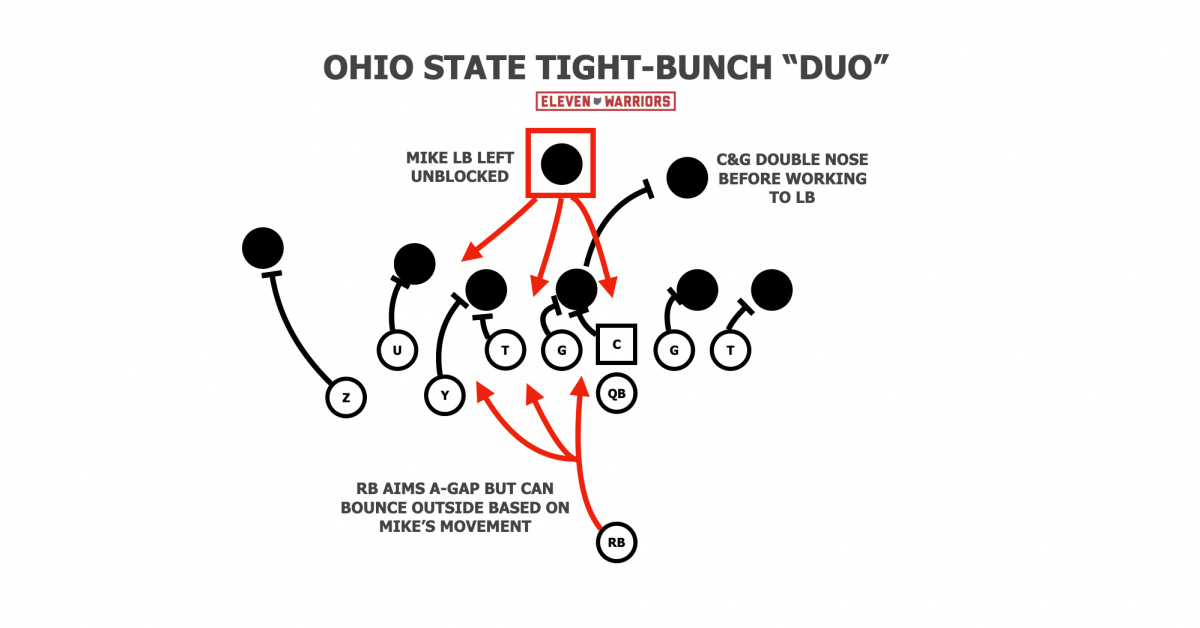
Trey Sermon showed an ability to not only read the Mike's movement (#8 above) against the Scarlet Knights but bounced runs outside with the requisite burst to get upfield. The Oklahoma graduate transfer had his best game yet in Scarlet and Gray, tallying 68 yards on 12 carries for an efficient 5.67 average on Saturday night in the 'shoe.
It wasn't just the concept itself that was notable, but the formation as well. In a tight bunch with both tight ends and the Z receiver (Olave) to one side, Day and Wilson clearly expected Rutgers to stay with two-deep safeties. When facing a run in that alignment, the cornerback is responsible for containing the runner (turning him back inside), while the deep safety is forced to come upfield to fill the extra gap created by aligning three players at the end of the line.
Though not explosive, this efficiency is the bedrock of Day's philosophy, as it forces defenses to respect the threat of a run.
“We want to have a play-action off of all of our runs," OSU's head coach said at a clinic back in 2019. "If you have a run that doesn’t have a play-action, then it’s not married up [correctly]. In a perfect world, you’d like to have a run, a play-action, and then a screen of that run as well."
As the Scarlet Knights saw firsthand, this approach is nearly unstoppable with Fields in command. On the very next series following the run from Sermon shown above, Day called for the same formation (just flipped the opposite way) but this time called a pass off the same Duo action.
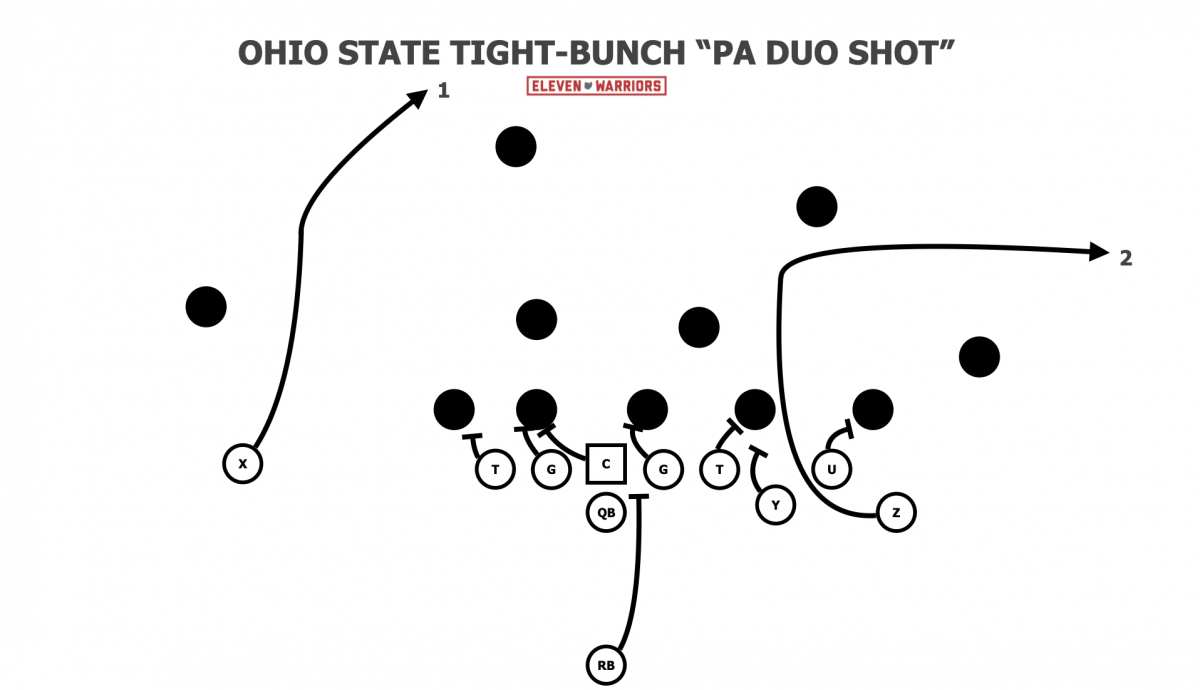
While the deep safety took away Fields' primary read (a deep post to Wilson), Olave got off the line clean by releasing inside of the tight end. From there, the dynamic wideout had a one-on-one matchup with the corner as the rest of the defense focused on stopping a handoff that never occurred. The result? An easy pitch and catch for a first down.
It's no surprise the Rutgers defense looked confused by such a simple concept, as they'd been torched by the same formation in multiple ways. Not only had the Buckeyes picked up yards on the ground from that tight bunch look, but they found the end zone after lining up that way.
On the snap following the Duo play with Sermon, Day again called the same formation with a pass off run-action. This time, the concept appeared to be a Mid-Zone handoff away from the bunch, only to see Fields keep for himself and roll back to the right. Though the defensive end to that side (#97) properly recognized the fake, Fields' athleticism bought enough time to let the play develop.
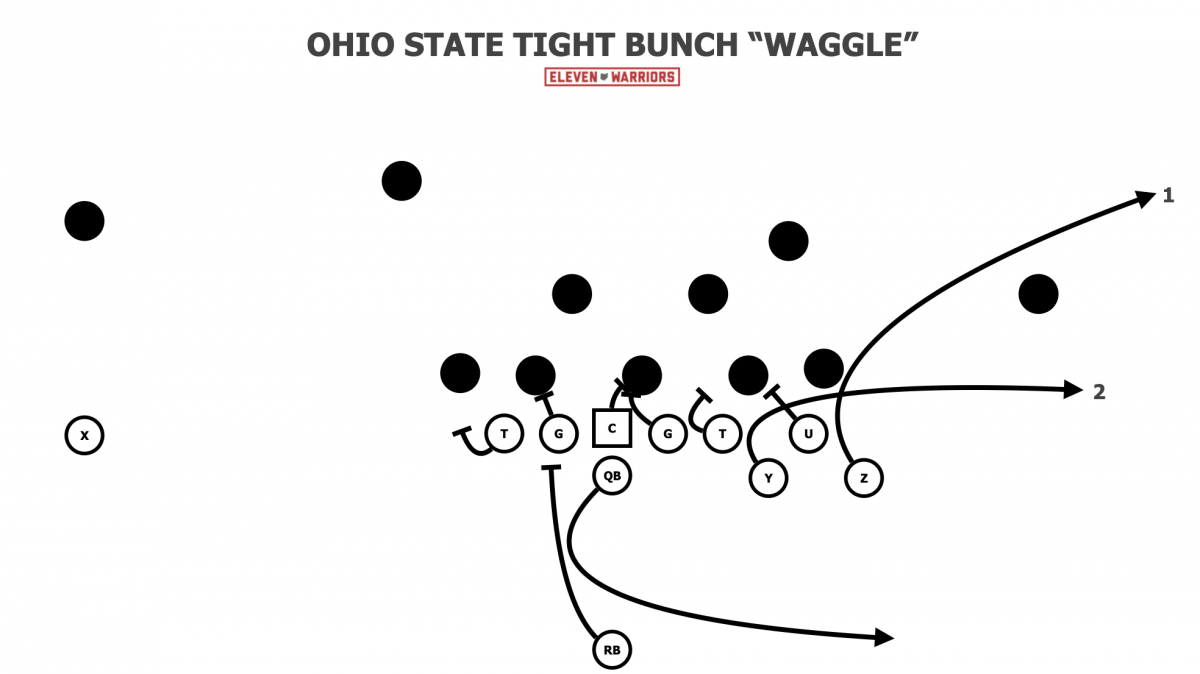
“It was just a naked play,” Fields said of the touchdown to Olave. “It worked out kind of like a scramble drill. We just work on it in practice, and it just happened like that in the game. We try to practice how we play, and that's how it turned out.”
That wouldn't turn out to be Olave's only touchdown out of that formation. Schiano's team kept fighting throughout the second half by unleashing a barrage of trick plays that made the blowout far more entertaining (feel free to go off in the comments, grumpy Buckeye fans) and kept OSU's starters in the game.
As if to send a message to both his own team and his opponents, Day sent the first-team offense back out on the field after Rutgers' Bo Milton returned a fourth-quarter punt 52 yards for a touchdown. Four plays after a failed onside kick gave the Buckeyes great field position, Day called for the tight bunch set again.
This time, Olave motioned across the formation before the snap, but another play-fake off Mid-Zone action froze the defense. Fields had plenty of time to wait for Olave to run right past the corner in a Cover 2 zone and drop in a beautiful pass at the pylon.
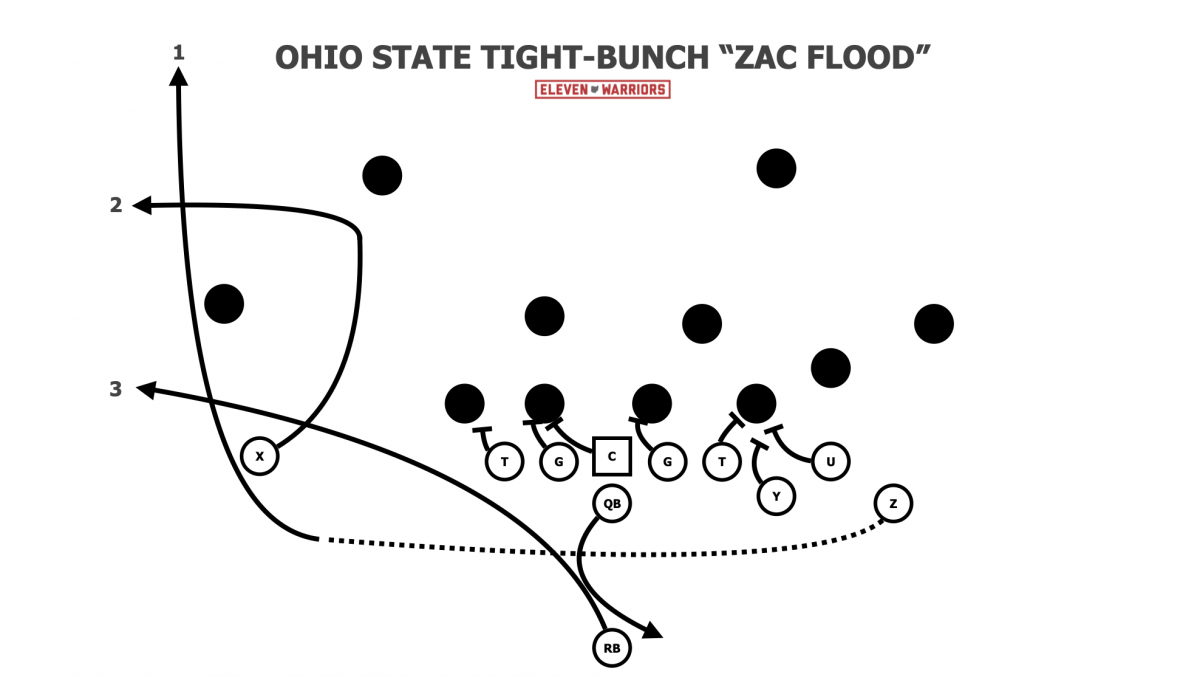
“He's really accurate down the field," Day said of his star QB. "I thought the last throw to Chris, he made that look like it was a 12-yard out. I've got to look back on film to see where it was, but that thing had gas and it was in the hole. It was one heck of a throw.”
With such accuracy downfield, Fields doesn't need much space to thread in a throw and make a big play. By playing relatively conservative on the ground and efficiently picking up yards, opposing defenses have to dedicate resources to stop it, even if it's not as dangerous as years past.
Meanwhile, Day and Wilson continue to look for new ways to keep defenses off-balance. In a throwback to the Jim Tressel era, the Buckeyes lined up in an I-formation on an early 3rd & 1 play with Ruckert as the fullback.
From this look, Ohio State incorporated another version of Duo in which that fullback acts as a lead blocker, similar to the old school Iso plays we saw for years in Columbus.
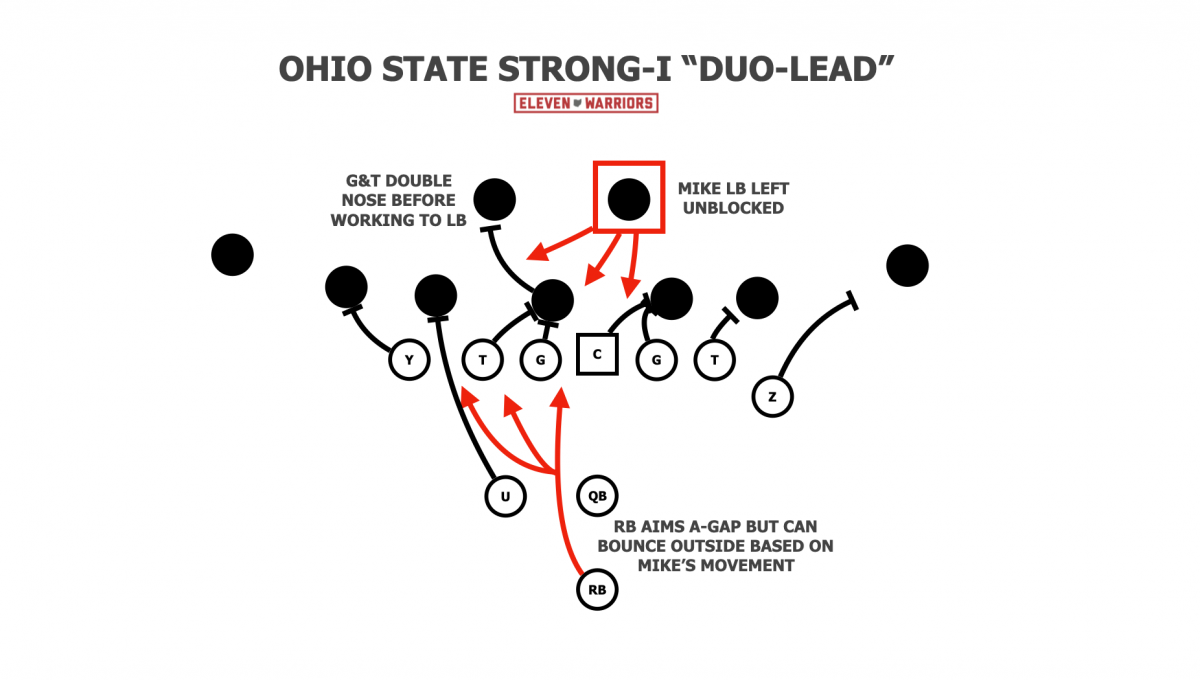
Though it was not a very notable result at the time, it also set up what was to come. Facing another 3rd & 1 in the second half, the Buckeyes returned to this setup, though this time with Fields under center instead of the pistol.
Just as he had before, Fields faked the handoff, rolled right, and looked to the back corner of the end zone. With the Rutgers corners taking that away this time, the QB simply checked down to Ruckert in the flat for a first down.
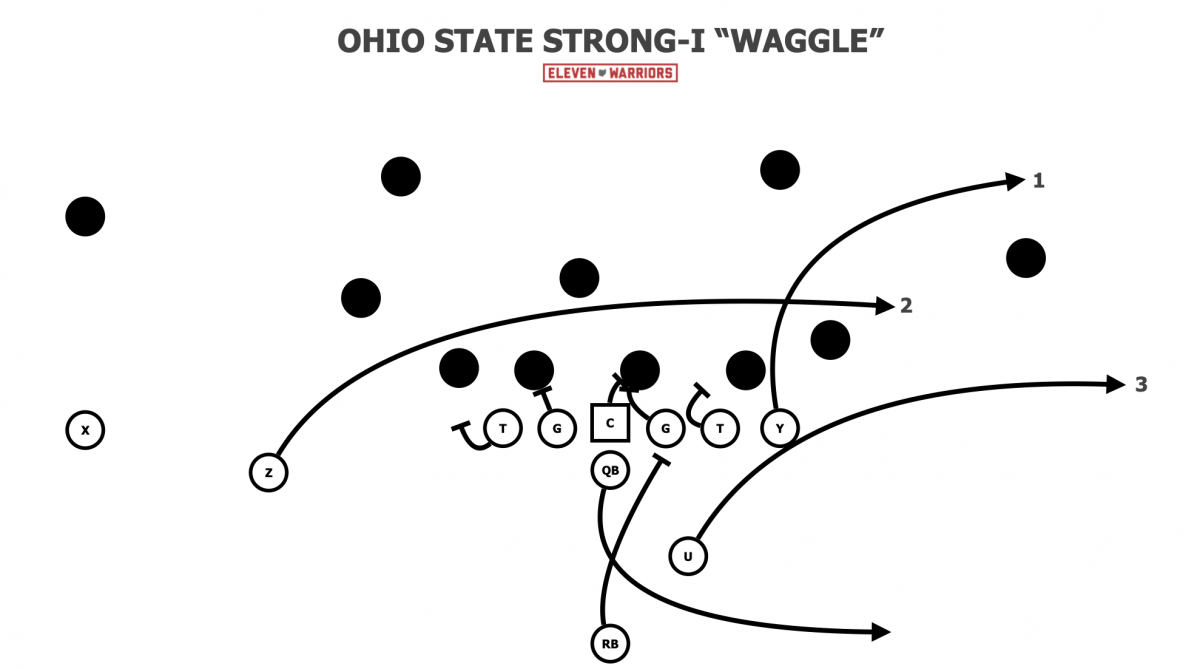
These are the kinds of plays that are often overlooked in highlight packages and forgotten by fans. But for opposing coaches, they are additional wrinkles from the same personnel package which can hurt the defense in a myriad of ways.
There is no doubt that Fields and the passing game are the most critical factor to Ohio State's success in 2020, but his coaches continue to be very deliberate about how and when to unleash it by running the ball with enough efficiency to keep opponents in conflict. What may be the most dangerous threat may not always be the most pressing, as the defenses from Nebraska, Penn State, and now, Rutgers, can attest.
